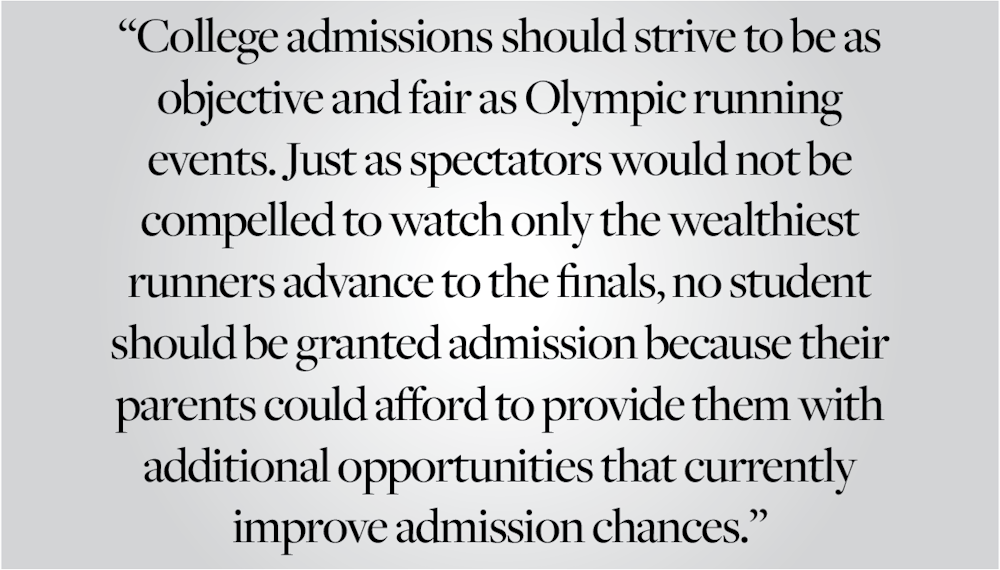At the Olympics, each track event starts with nearly 50 competitors in “heats,” where a certain relative time is required to reach the next round. The field is slowly whittled down until about 10 advance to the final.
Imagine if, at the 2024 Paris Olympics, the Olympic Committee changes this straightforward process to include factors other than race times. Runners who excel at non-track sports, have the most interesting bio on the Olympic website, or whose countries give the most money to the Olympic committee would receive a generous time adjustment. Most people would agree that this rule change would be ridiculous and comical.
Yet college admissions function similarly to this alternative universe Olympics. Admissions committees consider what I believe to be unfair and extraneous factors. Colleges like Brown should switch to a new admissions system: one where students must meet a minimum high school GPA and standardized testing requirement to apply. Applicants would then be entered into a lottery, where a certain number would be randomly selected for admittance.
College admissions at selective universities are broken, as illustrated by a recent, highly publicized study. Using a previously unavailable data set, researchers found that students from families in the top 1% (with a yearly income greater than or equal to $611,000) of the income ladder are twice as likely to attend an Ivy Plus university compared to middle-income students with similar SAT or ACT scores. This favoritism, according to the study, is a result of three main factors: legacy admissions, increased weighting of extracurriculars and the recruitment of student athletes.
The natural conclusion here is that admissions committees at top universities should not consider — or at least greatly deprioritize — the aforementioned admission considerations. Legacy admissions are, at best, a way to foster community, but are often just a tool for universities to bring in more alumni donations. Schools like Brown have multi-billion dollar endowments large enough to forgo the financial boost associated with legacy admissions (which may be a myth anyway).
Extracurriculars are similarly misunderstood. They certainly showcase students’ abilities outside of school and ensure that admitted students are interesting and well-rounded people. Still, schools do not need to select for this, as high-achieving students nearly always have impressive abilities outside of school — weighting for extracurriculars can force these students to overextend themselves.
Surprisingly, athlete recruitment is also misconceived. Recruiting athletes is perceived as a way to admit more disadvantaged students, but it actually does the opposite at elite universities. In reality, most high-level sports are expensive: Many sports, like fencing or equestrian, are largely inaccessible to lower-income high schoolers.
An admissions lottery would not consider any of these factors that favor wealthy (and usually white) applicants. Instead, it would focus on the most predictive, merit-based factors: standardized test scores and high school GPA, with occasional exceptions for students with particularly unusual circumstances. Both are some of the best measures we currently have in predicting future academic and professional success. Standardized test scores are far less biased when it comes to socioeconomic status or race when compared to other admissions criteria. They are also surprisingly hard to meaningfully improve on. High school GPA is similarly robust and also captures qualities, such as persistence and grit, that are not necessarily exhibited in a three-hour standardized test.
In some sense, admissions at Brown are already a lottery. The school receives far more applicants than it can ever hope to admit, and the admission committee must find razor-thin (and, I would argue, imaginary) distinctions between applicants. No matter how hard they try, it is impossible for these committees to truly be objective and not influenced by incidental factors. One study even found that committees favor academic achievements on cloudy days and non-academic ones on sunny days.
With this all said, here is how the Brown admissions lottery could work: all applicants who score at or above a 33 on the ACT or a 1470 on the SAT — which, according to College Board, are Brown’s minimum standardized testing requirements — and have a GPA in the top tenth of their graduating high school class will be admitted into a lottery. The school will then randomly select about 1,700 of these applicants to attend the next year (though, as I have previously argued, the acceptance rate should be higher). This lottery may be impossible in practice, but Brown could certainly experiment with it for a year or perhaps only use it for regular decision applicants. The school could then assess the lottery’s efficacy and adjust it for factors it may miss, similar to how the medical resident matching system has evolved over the decades. For example, they could add in weighting to ensure that Brown still enrolls a diverse class — though the lottery system would likely already better accommodate this than the current admissions system, even without adjustments.
College admissions should strive to be as objective and fair as Olympic running events. Just as spectators would not be compelled to watch only the wealthiest runners advance to the finals, no student should be granted admission because their parents could afford to provide them with additional opportunities that currently improve admission chances. The solution is an admissions lottery based on high school GPA and standardized testing scores. These metrics are not perfect, but are still the fairest available predictors of academic and professional success. If Brown implements this system, only academically deserving applicants will be able to cross the finish line onto College Hill.
Ben Aizenberg can be reached at benjamin_aizenberg@brown.edu. Please send responses to this op-ed to letters@browndailyherald.com and other op-eds to opinions@browndailyherald.com.





